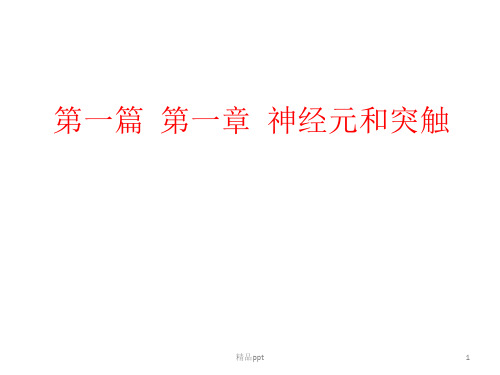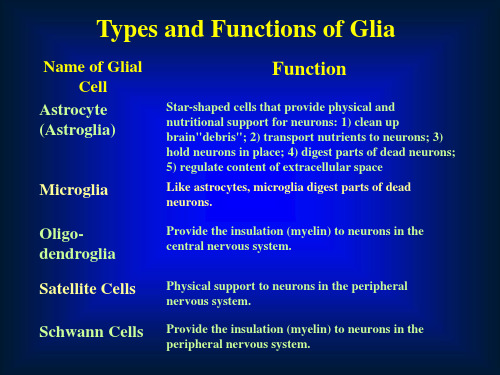神经元与神经胶质细胞优秀课件
神经元与神经胶质细胞ppt课件

精品ppt
28
朗飞氏结(Ranvier node)
少突胶质细胞与中枢有髓神经纤维
关系模式图
精品ppt
29
ቤተ መጻሕፍቲ ባይዱ
HE染色,高倍
*郎飞氏结
精品ppt
30
有髓神经纤维的横切面
精品ppt
31
有髓神经纤维电镜像 ×39000
精品ppt
32
⑤神经纤维的功能是传导兴奋,传导速度与神经纤维的 直径有关,即神经纤维直径越大,则传导速度越快。
分类:星形胶质细胞、少突胶质细胞、小胶质 细胞
功能: (1)支持作用 (2)修复和再生作用 (3)物质代谢和营养性作用 (4)绝缘和屏障作用 (5)维持合适的离子浓度 (6)摄取和分泌神经递质
精品ppt
44
中枢神经系统胶质细胞显微照片 镀银染色 高倍
左图:A.纤维性星形胶质细胞 B. 原浆性星形胶质细胞
精品ppt
19
树突的特征
①树突是胞体向外发出的树状突起,其内容物 和胞体大致相同,可将树突看作胞体的延续。
②树突起始较宽,反复分支,不断变细,长短 不一,通常短于轴突。
③树突内的细胞器随其分支变细而减少,甚至 消失。
④树突一般没有髓鞘。
精品ppt
20
精品ppt
21
⑤ 树突棘(dendritic spine)。一般认为树突棘是与其 它传入神经元形成突触的部位。
精品ppt
15
线粒体:细胞呼吸的场所,能量工厂
精品ppt
16
微管蛋白
微管
神经丝
微丝
细胞骨架的构成
精品ppt
17
细胞核
细胞核呈球型,由核膜包围 核内含有遗传物质DNA 基因表达的过程
神经元和神经胶质细胞2.ppt

二、神经元的分类
突起数
单极 双极 多极
功能
感觉 中间 运动
兴奋性 作 用 抑制性
递质
5-HT NE DA Ach …….
三、神经元的骨架
• 微管 • 微丝 • 神经丝
(一)微管(Microtubule)
神经元与胶质细胞
神经再生重点实验室 沈爱国
第一节 神经元
• 人脑大约有1011亿个神经元 • 大小, 形状各异
一、神经元的一般结构
• 1、胞体 2、突起:树突
轴突 3、终末
输入信号 整合信号
传导信号
输出信号
一、1、细胞胞体体
细胞膜
细胞核:Bar小体
细胞质 细胞器
尼氏小体 神经原纤维
细胞膜:液态脂质双分子层,其间镶嵌有 一些蛋白质
中间丝蛋白的类型与分布
四、神经元的胞浆运输-轴突转运
• 顺向转运和逆向转运 • 慢速转运和快速转运
轴突转运的主要 通过驱动蛋白的作 用,由ATP提供能 量,沿微管自胞体 向末梢运行
运动蛋白的再循环
第二节 神经胶质细胞
大胶质细胞
中枢胶质细胞
星形胶质细胞 (astrocyte) 少突胶质细胞(oligodendrocyte)
• C:巨噬细胞 • D:损伤变性的神
经细胞
其它类型的胶质细胞
• 室管膜细胞
脉络丛上皮细胞
小 结(1)
• 神经系统由神经元和神经胶质细胞构成。 • 神经元由胞体、突起(树突、轴突)、终
末构成。胞体是神经元的营养代谢和功能 活动中心;树突接受刺激,轴突将胞体发 出的冲动向其它神经元或效应器传递。 • 神经纤维包括有髓和无髓两种。有髓纤维 传导速度快于无髓纤维
第2章-神经元与胶质细胞-PPT

按递质分类
5-HT能神经元 NE能神经元 DA能神经元 Ach能神经元 …….
按电生理特性分类
兴奋性神经元 抑制性神经元
2.1.4 神经元间的联系
简单回路
辐散(divergence) 聚合(convergence) 链锁状和环状
不同层次 神经环路
不同核团或皮层脑区和之间的长投射纤维 同一核团或脑区的局部环路 相邻神经元不同成分间的微环路
小脑内局部神经元回路
1:藓苔纤维 2:攀缘纤维 3:小脑深部核团细胞 4:颗粒细胞 5:高尔基细胞 6:浦肯野细胞 7:篮状细胞 8:星状细胞 9:平行纤维 黑色细胞均为抑制性神经元
2.1.5 神经元特有蛋白 和代谢特点
纤维性星型胶质细胞 原浆性星型胶质细胞
多分布于脑和脊髓的白质,突起 细长,分支少,“蜘蛛细胞”, 富含胶质丝
多分布于灰质,突起粗短,分 支多,“苔状细胞”,较少胶 质丝
特殊的星形胶质细胞 Bergmann胶质细胞: 小脑皮质,原浆性为主 Muller胶质细胞:视网膜 垂体细胞:脑垂体后叶 伸展细胞:正中隆起
分类
大胶质细胞
中枢胶质细胞 (macroglia)
星形胶质细胞 (astrocyte) 少突胶质细胞(oligodendrocyte)
外周胶质细胞
小胶质细胞
(microglia)
施万细胞
(Schwann cell)
室管膜细胞 (ependymocyte)
脉络丛细胞 (choroidal
epithelial cell)
• 脑毛细血管表面85%-99%被其足板覆盖 神经元
动物生理学第三章-神经生理ppt课件

凡是能与乙酰胆碱结合的受体叫做胆碱能受体。
①毒蕈碱型受体(muscarinic receptor)或M受体,它与 乙酰胆碱结合时产生与毒蕈碱相似的作用。
②烟碱型受体(nicotinic receptor)或N受体,它与乙酰 胆碱结合时产生与烟碱相似的作用。
①M型受体存在于副交感神经节后纤维支配的效应细 胞上以及交感神经支配的小汗腺、骨骼肌血管壁上。当它 与乙酰胆碱结合时,则产生毒蕈碱样作用,也就是使心脏 活动受抑制、支气管平滑肌收缩、胃肠运动加强、膀胱壁 收缩、瞳孔括约肌收缩、消化腺及小汗腺分泌增加等。阿 托品可与M受体结合,阻断乙酰胆碱的毒蕈碱样作用,故 阿托品是M受体的阻断剂。(农药中毒)
3.突触前受体 4.中枢内递质的受体
②N受体又可分为神经肌肉接头和神经节两种亚型,它 们分别存在于神经肌肉接头的后膜(终板膜)和交感神经、 副交感神经节的突触后膜上,前者为N2,后者为N1受体类型。 当它们与乙酰胆碱结合时,则产生烟碱样作用,即可引起 骨骼肌和节后神经元兴奋。箭毒可与神经肌肉接头处的N2受 体结合而起阻断剂的作用;六烃季胺可与交感、副交感神 经节突触后膜上的N1受体结合而起阻断剂的作用。
通过弥散作用到效应器细胞 效应细胞发生反应
非突触性化学传递的特点
①不存在突触前膜与突触后膜的特化结构。
②不存在一对一的支配关系,即一个曲张体能支配 较多的效应细胞。 ③曲张体与效应细胞间的距离至少在200Å以上,距 离大的可达几个μm。
④递质的弥散距离大,因此传递花费的时间可大于1s。 ⑤递质弥散到效应细胞时,能否发生传递效应取决于 效应细胞膜上有无相应的受体存在。
③电紧张扩布。局部电位不能像动作电位向远处传播,只 能以电紧张的方式,影响附近膜的电位。电紧张扩布随扩 布距离增加而衰减。
神经总论-神经元和神经胶质细胞PPT

第十章神经系统的功能 1.神经系统总论:神经系统功能活动的基本原理(线下自主学习)2.神经系统的感觉分析功能(线上学习视频10.1)3.神经系统对躯体运动的调控(线上学习视频10.2)4.神经系统对内脏活动的调控(线下自主学习)5.脑电活动和睡眠(线下自主学习)6.脑的高级功能(记忆和语言)(线下自主学习)说明:学习前请通读人卫社第九版《生理学》第十章内容。
主要内容:1.神经元和神经胶质细胞2.突触传递过程、影响因素3.神经递质与受体4.突触的中枢抑制与易化总论包括:外周神经系统(PNS)中枢神经系统(CNS)神经节(ganglion)图示为位于脊髓两旁的初级躯体感觉传入神经节:背根神经节(dorsal root ganglion, DRG)•定义:功能相同的神经元胞体在中枢以外的周围部位集合而成的结节状结构。
•按生理和形态的不同,神经节可分为:1)脑脊神经节(感觉神经节):在功能上属于感觉神经元,在形态上属于假单极或双极神经元。
2)植物神经节:包括交感和副交感神经节。
位置?(交感神经节:脊柱两旁;副交感神经节:所支配器官的附近或器官壁内)中枢神经系统的功能分级1)脊髓水平2)低位脑水平(皮层下水平)3)高位脑水平(皮层水平)1)脊髓水平基本的运动反射(肌牵张反射,屈肌反射和对侧伸肌反射,基本的步态反射。
) 发汗反射,血管张力,胃肠道反射排尿,排便反射2)低位脑水平(皮层下水平)延髓脑桥中脑下丘脑丘脑小脑基底神经节3)高位脑水平(皮层水平)•1. The patients lost their ability to solve complex problems.•2. They became unable to string together sequential tasks to reach complex goals.•3. They became unable to learn to do several parallel tasks at the same time.•4. Their level of aggressiveness was decreased, sometimes markedly, and, in general, they lost ambition.• 5. Their social responses were often inappropriate for the occasion, often including loss of morals.• 6. The patients could still talk and comprehend language, but they were unable to carry through any long trains of thought, and their moods changed rapidly from sweetness to rage to exhilaration to madness.•7. The patients could also still perform most of the usual patterns of motor function that they had performed throughout life, but often without purpose.前额叶切除(Prefrontal lobotomy )不能处理多任务和解决较复杂的问题没有进取心和抱负社交能力下降,或者社交恐惧不能进行有效的逻辑推理和思考,情绪剧烈波动能进行日常的运动功能,但通常没有目的性。
21神经元和神经胶质细胞-神经元.ppt

Structure of Neurons
• Cell body (soma; perikaryon)
• Axon : only one (branches are collaterals;
terminals are end feet)
• Dendrites : much shorter; one or more than one; branch extensively into dendritic trees
2021/3/24
Neuroglia
胞体
• 二、神经元
树突 轴突
•
• 1.结构
神经胶质细胞
•
• 胞体
•
树突
• 突起轴突 神经末梢
2021/3/24
• (1)胞体 soma • 是神经元营养和代谢的中心,主要位于 • 脑皮质,脊髓的灰质以及神经节内。
2021/3/24
• ① 细胞膜 cell membrane • 可兴奋膜,感受刺激,传导神经冲动。
Smooth surface
Generally only 1 axon per cell
Rough surface (dendritic spines) Usually many dendrites per cell
No ribosome
Have ribosomes
Can have myelin
Branch further from the c2e02l1l/3/b24ody
• Axon: Longest process transmits
messages away from cell body
• Dendrites: Multiple processes off cell
医学课件神经元和神经胶质细胞-胶质细胞

Name of Glial Cell
Astrocyte (Astroglia)
Microglia
Oligodendroglia
Function
Star-shaped cells that provide physical and nutritional support for neurons: 1) clean up brain"debris"; 2) transport nutrients to neurons; 3) hold neurons in place; 4) digest parts of dead neurons; 5) regulate content of extracelluroglia digest parts of dead neurons.
3. Neurons HAVE synapses that use neurotransmitters. Glial cells do NOT have chemical synapses.
4. Neurons do NOT continue to divide. Glial cells DO continue to divide.
Provide the insulation (myelin) to neurons in the central nervous system.
Satellite Cells Schwann Cells
Physical support to neurons in the peripheral nervous system.
• Express receptors for almost all neurotransmitters and neuromodulators
神经元、神经纤维和神经胶质细胞ppt课件

ppt精选版
10
4.神经纤维的传导速度 Nerve conduction velocity, NCV ⑴ 影响传导速度的因素: ① 纤维直径:与直径成正比; V(m/s)=6×D(总直径,μm), 其中:D = 轴索 + 髓鞘厚度;
ppt精选版
11
② 轴索与总直径的比值: 比值 = 0.6,为最适比例;
ppt精选版
18
② 已分离出的NT: 神经生长因子 (NGF) 神经营养因子-3 (NT-3) 神经营养因子4/5 (NT-4/5) 脑源性神经营养因子(BDNF)
ppt精选版
19
⑵ 神经营养因子的运输:NT作用于神 经末梢的特异受体→被末梢摄取→ 逆向轴浆运输→胞体。
⑶ 神经末梢的NT受体:有三种,分别 是Trk A、Trk B和Trk C。
ppt精选版
3
2.基本功能:
A.功能部位 ① 受体部位; ② 产生AP的起始部位; ③ 传导神经冲动部位; ④ 释放神经递质部位;
ppt精选版
4
B.神经元基本功能 ① 感受内外环境变化的刺激; ② 传导兴奋; ③ 整合、分析、贮存信息; ④ 神经-内分泌功能。
ppt精选版
5
(二)神经纤维的兴奋传导和纤维类型 1.神经纤维(Nerve fiber): 轴突和感觉神经元的长树突统称 轴索(neurite)。 轴索及其外面包裹的髓鞘myelin sheath或神经膜(neurilemma)构 成神经纤维。
⑵ 逆向轴浆运输 (Retrograde axoplasmic trasport) 自末梢向胞体的运输。如狂犬病病 毒、破伤风毒素等的运输。
ppt精选版
17
(四)神经的营养作用和支持神经的营养 性因子
- 1、下载文档前请自行甄别文档内容的完整性,平台不提供额外的编辑、内容补充、找答案等附加服务。
- 2、"仅部分预览"的文档,不可在线预览部分如存在完整性等问题,可反馈申请退款(可完整预览的文档不适用该条件!)。
- 3、如文档侵犯您的权益,请联系客服反馈,我们会尽快为您处理(人工客服工作时间:9:00-18:30)。
神经元的一般结构--细胞体
神经元的细胞体
• 细胞膜
脂质双层,镶嵌蛋白
• 细胞质
尼氏体,神经原纤维,内质网,
高尔基复合体,溶酶体,多泡体,线粒体,
中心粒和纤毛,色素颗粒和脂褐素
• 细胞核
细胞膜
液态的脂质双层中镶嵌着球形蛋白
骨架是磷脂双分子层。 蛋白质分子以附着、镶嵌、贯穿的形式存在于磷脂双分子层上
Dendrite
• The part of the soma that does concern itself with the signal is the axon hillock. If the aggregate input is greater than the axon hillock's threshold value, then the neuron fires, and an output signal is transmitted down the axon. The strength of the output is constant, regardless of whether the input was just above the threshold, or a hundred times as great. The output strength is unaffected by the many divisions in the axon; it reaches each terminal button with the same intensity it had at the axon hillock. This uniformity is critical in an analogue device such as a brain where small errors can snowball, and where error correction is more difficult than in a digital system
细胞膜
细胞质
特征性结构: 1. 尼氏体:光镜下为嗜碱性小块或小颗粒,分布
与整个胞体和树突,轴突和轴丘中没有;电镜 下由粗面内质网、游离核糖体和多核糖体所构 成; 2. 神经原纤维,存在与胞体与突起中,电镜下相 当于微管、神经丝和微丝; 3. 线粒体特征:嵴纵向排列,线粒体内膜所围成 的腔室,其致密颗粒不常出现或缺如。
神经元胞体光镜结构,示尼氏体
细胞质
核糖体: 强噬碱性 游离型,主要合成结构蛋白 结合型,参与酶的合成 单个存在时无活性,只有当mRNA 将它串连起来并形成多核 蛋白体时才具有合成蛋白质的能力。
细胞质
高尔基器:存在于细胞核和树突近端。由几层扁平囊泡、 大泡所构成。小泡由光面内质网出芽更新而来,并携带 有粗面内质网合成的多肽和蛋白质等,故又称转移小泡。 通过扁平囊泡的加工浓缩,然后脱落成大泡。 可能参与突触小泡的形成和合成多肽激素的神经分泌颗 粒; 还可形成溶酶体
线粒体
为细胞活动提供能量 胞 树突
神经元突起
Dendrite
• A neuron’s dendritic tree is connected to a thousand neighbouring neurons. When one of those neurons fire, a positive or negative charge is received by one of the dendrites. The strengths of all the received charges are added together through the processes of spatial and temporal summation. Spatial summation occurs when several weak signals are converted into a single large one, while temporal summation converts a rapid series of weak pulses from one source into one large signal .
Dendrites
• The treelike extensions of a neuron. Most neurons have multiple dendrites, which are short and typically highly branched. Dendrites are specialised for receiving information and form synaptic contacts with the terminals of other nerve cells to allow nerve impulses to be transmitted.
树突
一、树突 树突棘(spine) 分为细长型或鼓槌型 (drum,stick shape),牙型(stubby shape), 蘑菇型(mushroom shape)。
二、是突触后膜所在部位,也是外来冲动传 入部位。
Function of spines
• Dendritic spines are the contact sites for most excitatory synapses in the brain where they occur in vast numbers, estimated to be on the order of 1014 for the human cerebral cortex. Spines are particularly associated with neurons where inputs from diverse sources converge, such as pyramidal cells in the cerebral cortex, whose dendrites commonly have several thousand spines, each representing an excitatory synapse.
树突
树突内的结构与核周质基本相似, 微管是树突最明显的细胞器 树突侧棘,是神经元之间形成突触的主要部位,功能尚不清 在大脑皮质锥体细胞和小脑皮质蒲肯野细胞的树突上,树突棘 数量最多而明显,一个蒲肯野细胞的树突棘可多达10万个以上。 树突的功能主要是接受刺激,树突棘和树突使神经元的接受面 大为扩大。
